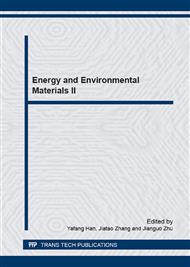[1]
R. CHEN, J. LIU, Y.S. PANG, 1Cr18Ni9Ti stainless steel's intergranular corrosion experimental study [J]. Journal of He Nan Metallurgy. 2006, 14 (4) : 15-17.
Google Scholar
[2]
Z.D. CUI, H.S. LIU, Metal materials and Heat treatment [M]. Central South University Press, 2010: 321-326.
Google Scholar
[3]
R.L. ZUO. Material sci. Chongqing University Press [M], 2008: 85-90.
Google Scholar
[4]
J. WANG, The Harm of Intergranular Corrosion and the reason analysis [J]. Journal of Foundry Technology, 2011: 1756-1759.
Google Scholar
[5]
P. ZHANG, Vibration drilling the 0Cr18Ni9Ti stainless steel micro-hole [J]. Applied Mechanics and Materials, 2012, 217: 1592-1595.
DOI: 10.4028/www.scientific.net/amm.217-219.1592
Google Scholar
[6]
Toshio Yonezawa, The Effect of Chemical Composition and Heat Treatment Conditions on Stacking Fault Energy for Fe-Cr-Ni Austenitic Stainless Steel [J]. Metallurgical and Materials Transactions A, 2013, 44(13): 5884-5896.
DOI: 10.1007/s11661-013-1943-0
Google Scholar
[7]
A. Kriaa. Erratum to: Statistical Modeling of Electrochemical Reactivation Conditions for Detecting Sensitization to IGC of Austenitic Stainless Steel Type 316L, [J]. Surface Engineering and Applied Electrochemistry, 2010, 46(5): 534.
DOI: 10.3103/s1068375510050200
Google Scholar
[8]
J.X. WANG, The Influence of Heat Treatment Process on the Microstructure and Mechanical Properties of 0Cr17Ni4Cu4Nb Stainless Steel [J]. Metal Heat, 2012, 37(11): 90-94.
Google Scholar
[9]
Q.Y. SHI. The Study of Heat Treatment Process on 304 austenitic stainless steel [J]. Sci, Techno, and Engin. 2011, 11 (24) : 5910-5912.
Google Scholar
[10]
Han Tao, etc. Such as grain boundary character distribution optimization to improve the 304 stainless steel intergranular corrosion study [J]. Journal of hot working process. 2011, 40 (14) : 59-109.
Google Scholar
[11]
H. Zhao, L. Xu, Heat treatment on the corrosion performance of duplex stainless steel organization and influence [J]. Journal of corrosion science and protection technology, 2009, 21 (3) : 288-290.
Google Scholar
[12]
L.H. Gong, Y. Zhang, Effect of heat treatment on corrosion resistance of steel 0Cr18Ni9Ti [J]. Metal Science and Heat Treatment. 2009, 51: 553-556.
DOI: 10.1007/s11041-010-9209-6
Google Scholar


